Forget your regular breakfast blend tea. At the Garden of Re-Imagination just outside Glengarriff, you can try… west Cork blend?
“Hawthorn blossom, pepper mint and apple mint tea,” smiles Kloë Wood Lyndorff, as she sets down a China cup, along with a generous slice of homemade nettle and honey cake, sprinkled with marigold and fuchsia petals.
Though if you are more of a traditional tea drinker; well, they grow that too.
“If you like Barry’s Tea, we grow tea camellias,” points out Kloë’s partner, Adam Carveth, as he leads Irish Country Living around their forest garden later on. “It grows really well here!”
Well, in that case, they’ll never go thirsty; or hungry. Because every flower or shrub planted by the pair has an edible function.
And through their business, Two Green Shoots, Kloë and Adam hope to inspire more people to create more biodiverse, resilient and delicious gardens.
Planting the seed
West Cork is where Kloë calls home; though with a few detours along the way.
The daughter of a mixed media artist and a war correspondent, she was actually born in Cyprus while her father was covering the Middle East, before moving to Venezuela, followed by Costa Rica.
While beautiful places, they were also “incredibly dangerous” at that time for a young family.
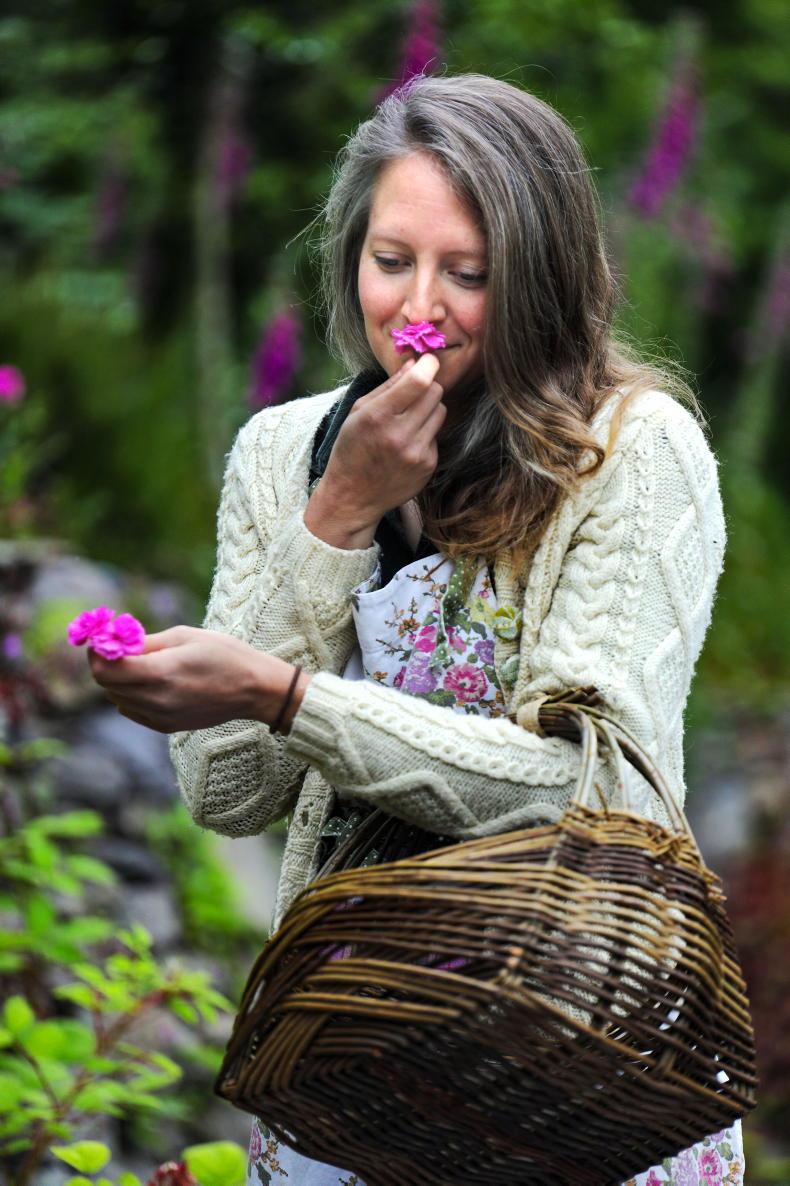
Kloë Wood Lyndorff was born in Cyprus and lived in Venezuela and Costa Rica before her family moved to West Cork. \ Valerie O'Sullivan
“People were being shot for a pair of trainers,” she says. “Having two little girls -the reality of that line of work and also the constantly moving, really started to hit home.”
Her mother is half-Irish, however, so when Kloë was four, her parents moved first to Mizen Head, later re-locating to Glengarriff, where they run the Ewe Experience interactive sculpture garden.
Growing up, Kloë says west Cork was “this unbelievable playground”. Until…
“You then hit your teens!” she laughs. “I could not wait to get away from Ireland, I really was ready for a bit of change.”
Kloë left home to study zoology in Wales, before completing a masters in sustainable development in Exeter. While heading down the Phd route in Cornwall, however, she began to experience “burnout” and having volunteered in community gardens, decided to set one up herself as “an antidote” to the academic environment.
Which is where she also met Adam.
“I was looking for a guest workshop facilitator for a session in that community garden and I spotted Adam in the local paper- he was the [gardening] columnist- and I thought, ‘Whoa!’” she laughs.
“I don’t know what stalking in horticultural terms would be?!” jokes Adam in response.
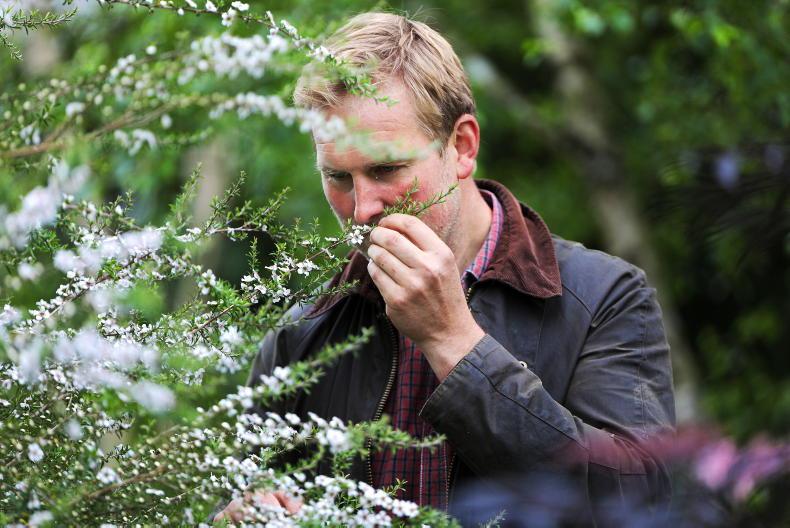
Adam Carveth trained with the RHS in the UK and worked with the National Trust before moving to Ireland. \ Valerie O'Sullivan
From Probus in Cornwall, Adam has been gardening for as long as he can remember, sowing sweet peas with his mother as a child and playing hide and seek amongst the runner beans.
However, he was actually planning to go to Australia to train as a policeman when his mother told him that the nearby Trewithen garden estate was looking for volunteers.
“She wanted to get rid of me because I was just taking over her garden!” he laughs.
Volunteering led to Adam studying with the Royal Horticultural Society and going on to work with The National Trust, before becoming head gardener at Knebworth House - known for its rock concerts - where he was in charge of 28 acres of formal historic gardens.
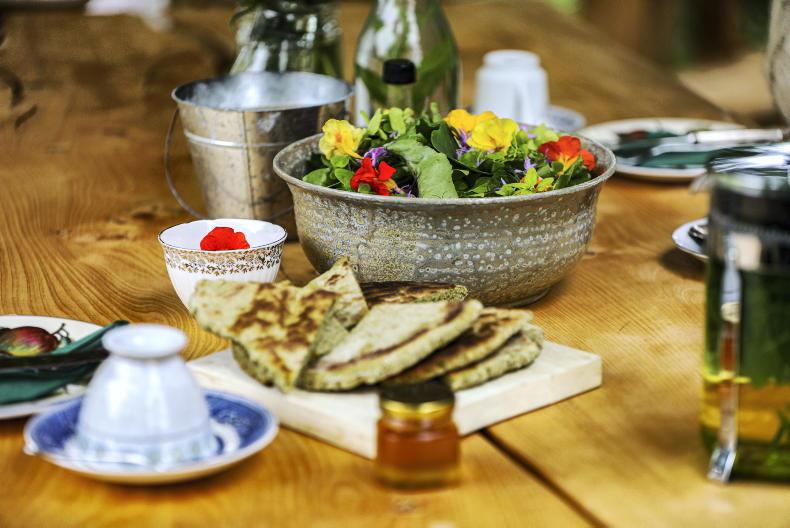
Visitors to The Garden of Re-Imagination can enjoy dishes prepared with ingredients foraged from the edibled forest. \ Valerie O'Sullivan
The higher he rose in rank, however, the further he got from doing what he really loved.
“My hands were getting less dirty and less calloused,” he says.
By now, Kloë was working for an environmental community charity as a projects officer; setting up horticultural therapy projects in homeless shelters. Like Adam, however, she was longing for something of her own.
“No matter how much variety I had, I was still doing other people’s projects,” says Kloë, explaining that it was her mother who initially planted the seed for returning to Ireland.
“Over the course of a few months, there were definitely loads of seeds being thrown!” she says.
“Literally chucked at us!” laughs Adam
“And at some point, we just ended up on the ferry,” says Kloë of their return in September 2017.
Edible garden
When Kloë’s parents had moved to Glengarriff a few years beforehand, the site they bought for The Ewe Experience came with two properties; the second of which they had renovated and let out.
This is where Kloë and Adam moved to; but it was the garden - which was overgrown and a jungle of rhododendron and griselinia - that caught their imagination, especially after they discovered stone walls and paths that had been hidden for years.
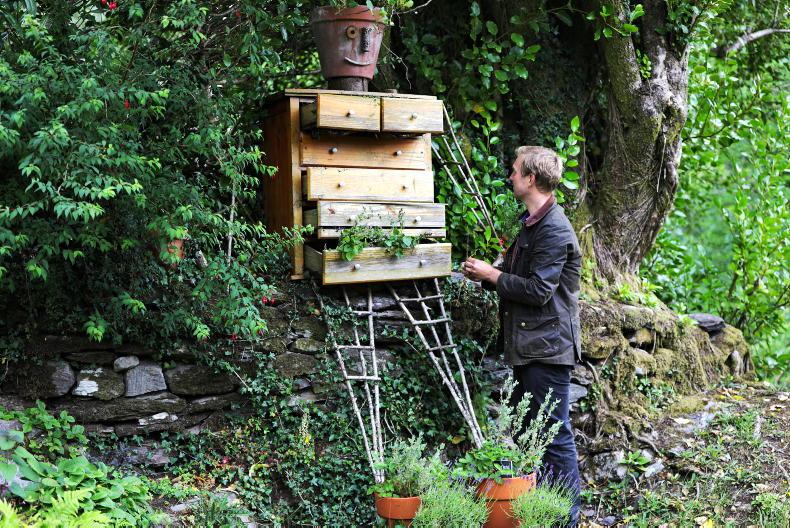
The Garden of Re-Imagination is full of surprises. \ Valerie O'Sullivan
“It was actually amazing the adventure of re-discovering this garden and the clink of hitting those giant stone steps with a spade,” recalls Kloë.
Having cleared back some of the over-growth to allow “light and life” back in, the next step was to put their own stamp on the garden. In the UK, Kloë had done a permaculture design course and was inspired by the work of Martin Crawford, who is known for creating edible forest-style gardens.
Could they replicate this in Glengarriff?
Well yes, is the answer. And the results might surprise you. As well as more exotic edibles like Chilean guava topiary, Szechuan pink peppercorns and mini kiwi type fruits (yes, west Cork kiwis!), Kloë and Adam have also introduced more recognisable plants that would not usually be known as a source of food.
For example, the black lace elder, they explain, turns elderflower cordial the prettiest shade of pink, hostas can be harvested like asparagus, dahlias have a sweet potato-like tuber underground, while even the most maligned “weeds” have their very own secret super-powers.
“My number one most popular drink is dandelion root lattes,” says Kloë.
“I actually cultivate dandelions for that and you literally just roast the roots, grind them up in a coffee grinder as you would your beans and into your latte, and caffeine free. And people are weeding them out! I’m like, ‘You have half a cup of coffee there!’”
Having started to create their own forest garden, however, Kloë and Adam wanted to inspire others to consider doing likewise. This has led to them opening it up as “The Garden of Re-Imagination” from June to mid-September, combining garden tours with a tasting experience.
“I’d get them to rub things, I’d get them to smell, I’ll get them to try things as long as there’s no allergies and they’re happy to try things,” says Adam of the garden tour element, “so it’s all about opening people’s eyes and tastes and senses.”

A tea made with ingredients foraged from the garden. \ Valerie O'Sullivan
Guests then enjoy produce from the garden- as well as other locally foraged ingredients- prepared by Kloë, with breakfast, lunch and afternoon tea tours on offer.
The day that Irish Country Living visited, for example, guests on the lunch tour had enjoyed sea spaghetti waffles with a nettle hummus dip, fuki risotto with caramelised broad beans and capers made from wild garlic seed heads, with nettle and honey cake for dessert.
The hope is that participants will go home with full tummies; and heads brimming with new ideas.
“I think gardens for me are this real multi-sensory experience,” says Kloë. “Getting people to move beyond plodding around a garden and going, ‘Ah sure, that’s nice’ and actually going, ‘God that tastes amazing and that smells incredible’ and learning how they can take some of that home with them.”
Branching out
As well as tasting tours, Adam and Kloë offer accommodation in their botanical-themed B&B for private groups of four to six people, as well as a bell tent for two in its own private forest clearing.
Off-season, then, they provide a garden design service for people who wish to replicate a little of what they are doing in their own back yards.
“They are really worried about the biodiversity crisis and climate breakdown that we’re seeing and they’re wanting, in their own small way, to do something and they might have a town garden right up to two acres or more,” says Kloë of their clientele.
Asked for simple tips to boost biodiversity in a garden, Kloë and Adam agree that putting a pond in is the “single best thing”. But if that’s not an option?
“Dead wood,” responds Kloë. “We get so fixated on pollinator plants and pretty flowers, but actually it’s dead wood. And it doesn’t sound very sexy, but what we try and do is create structures using it… they’re like giant bug hotels.”
(Indeed, examples of this can be seen at The Garden of Re-Imagination, such as a feature wall/fence made from dead wood.)
As for introducing trees and plants, they agree that hedging like elaeagnus is a good choice for most gardens, as is the amelanchier tree.
“It’s a small tree, grows in most soil conditions and the birds adore the berries; and the berries taste like sweet blueberries,” says Adam.
For those who want to cultivate a meadow, meanwhile, the yellow rattle is a good starter plant.
“It’s like a parasitic plant where it will literally weaken the grass species- it won’t kill them, it will just feed off them- and by doing that, it actually allows other species to move in,” explains Adam.
“So I always think that is the first wildflower plant you want to put in, because it will open the door should we say to other species to move in, because the seeds are already around.”
Ultimately, they explain, they want to encourage people to build more resilient gardens for the future; while building a resilient business in rural Ireland themselves.
“Having these three branches to the business is incredible,” says Kloë. “It means that so far, through this pandemic and through other crises that are happening, there’s usually one branch that can grow away while the others are in hibernation or dormancy; and also from our point of view, we love having that variety.”
Tours start at €22.50 per person. For further information, visit www.twogreenshoots.com
Read more
Planting for the next generation at Future Forests
Meet The Maker: Ann Marie O’Leary of The Flower Press Company
Forget your regular breakfast blend tea. At the Garden of Re-Imagination just outside Glengarriff, you can try… west Cork blend?
“Hawthorn blossom, pepper mint and apple mint tea,” smiles Kloë Wood Lyndorff, as she sets down a China cup, along with a generous slice of homemade nettle and honey cake, sprinkled with marigold and fuchsia petals.
Though if you are more of a traditional tea drinker; well, they grow that too.
“If you like Barry’s Tea, we grow tea camellias,” points out Kloë’s partner, Adam Carveth, as he leads Irish Country Living around their forest garden later on. “It grows really well here!”
Well, in that case, they’ll never go thirsty; or hungry. Because every flower or shrub planted by the pair has an edible function.
And through their business, Two Green Shoots, Kloë and Adam hope to inspire more people to create more biodiverse, resilient and delicious gardens.
Planting the seed
West Cork is where Kloë calls home; though with a few detours along the way.
The daughter of a mixed media artist and a war correspondent, she was actually born in Cyprus while her father was covering the Middle East, before moving to Venezuela, followed by Costa Rica.
While beautiful places, they were also “incredibly dangerous” at that time for a young family.

Kloë Wood Lyndorff was born in Cyprus and lived in Venezuela and Costa Rica before her family moved to West Cork. \ Valerie O'Sullivan
“People were being shot for a pair of trainers,” she says. “Having two little girls -the reality of that line of work and also the constantly moving, really started to hit home.”
Her mother is half-Irish, however, so when Kloë was four, her parents moved first to Mizen Head, later re-locating to Glengarriff, where they run the Ewe Experience interactive sculpture garden.
Growing up, Kloë says west Cork was “this unbelievable playground”. Until…
“You then hit your teens!” she laughs. “I could not wait to get away from Ireland, I really was ready for a bit of change.”
Kloë left home to study zoology in Wales, before completing a masters in sustainable development in Exeter. While heading down the Phd route in Cornwall, however, she began to experience “burnout” and having volunteered in community gardens, decided to set one up herself as “an antidote” to the academic environment.
Which is where she also met Adam.
“I was looking for a guest workshop facilitator for a session in that community garden and I spotted Adam in the local paper- he was the [gardening] columnist- and I thought, ‘Whoa!’” she laughs.
“I don’t know what stalking in horticultural terms would be?!” jokes Adam in response.

Adam Carveth trained with the RHS in the UK and worked with the National Trust before moving to Ireland. \ Valerie O'Sullivan
From Probus in Cornwall, Adam has been gardening for as long as he can remember, sowing sweet peas with his mother as a child and playing hide and seek amongst the runner beans.
However, he was actually planning to go to Australia to train as a policeman when his mother told him that the nearby Trewithen garden estate was looking for volunteers.
“She wanted to get rid of me because I was just taking over her garden!” he laughs.
Volunteering led to Adam studying with the Royal Horticultural Society and going on to work with The National Trust, before becoming head gardener at Knebworth House - known for its rock concerts - where he was in charge of 28 acres of formal historic gardens.

Visitors to The Garden of Re-Imagination can enjoy dishes prepared with ingredients foraged from the edibled forest. \ Valerie O'Sullivan
The higher he rose in rank, however, the further he got from doing what he really loved.
“My hands were getting less dirty and less calloused,” he says.
By now, Kloë was working for an environmental community charity as a projects officer; setting up horticultural therapy projects in homeless shelters. Like Adam, however, she was longing for something of her own.
“No matter how much variety I had, I was still doing other people’s projects,” says Kloë, explaining that it was her mother who initially planted the seed for returning to Ireland.
“Over the course of a few months, there were definitely loads of seeds being thrown!” she says.
“Literally chucked at us!” laughs Adam
“And at some point, we just ended up on the ferry,” says Kloë of their return in September 2017.
Edible garden
When Kloë’s parents had moved to Glengarriff a few years beforehand, the site they bought for The Ewe Experience came with two properties; the second of which they had renovated and let out.
This is where Kloë and Adam moved to; but it was the garden - which was overgrown and a jungle of rhododendron and griselinia - that caught their imagination, especially after they discovered stone walls and paths that had been hidden for years.

The Garden of Re-Imagination is full of surprises. \ Valerie O'Sullivan
“It was actually amazing the adventure of re-discovering this garden and the clink of hitting those giant stone steps with a spade,” recalls Kloë.
Having cleared back some of the over-growth to allow “light and life” back in, the next step was to put their own stamp on the garden. In the UK, Kloë had done a permaculture design course and was inspired by the work of Martin Crawford, who is known for creating edible forest-style gardens.
Could they replicate this in Glengarriff?
Well yes, is the answer. And the results might surprise you. As well as more exotic edibles like Chilean guava topiary, Szechuan pink peppercorns and mini kiwi type fruits (yes, west Cork kiwis!), Kloë and Adam have also introduced more recognisable plants that would not usually be known as a source of food.
For example, the black lace elder, they explain, turns elderflower cordial the prettiest shade of pink, hostas can be harvested like asparagus, dahlias have a sweet potato-like tuber underground, while even the most maligned “weeds” have their very own secret super-powers.
“My number one most popular drink is dandelion root lattes,” says Kloë.
“I actually cultivate dandelions for that and you literally just roast the roots, grind them up in a coffee grinder as you would your beans and into your latte, and caffeine free. And people are weeding them out! I’m like, ‘You have half a cup of coffee there!’”
Having started to create their own forest garden, however, Kloë and Adam wanted to inspire others to consider doing likewise. This has led to them opening it up as “The Garden of Re-Imagination” from June to mid-September, combining garden tours with a tasting experience.
“I’d get them to rub things, I’d get them to smell, I’ll get them to try things as long as there’s no allergies and they’re happy to try things,” says Adam of the garden tour element, “so it’s all about opening people’s eyes and tastes and senses.”

A tea made with ingredients foraged from the garden. \ Valerie O'Sullivan
Guests then enjoy produce from the garden- as well as other locally foraged ingredients- prepared by Kloë, with breakfast, lunch and afternoon tea tours on offer.
The day that Irish Country Living visited, for example, guests on the lunch tour had enjoyed sea spaghetti waffles with a nettle hummus dip, fuki risotto with caramelised broad beans and capers made from wild garlic seed heads, with nettle and honey cake for dessert.
The hope is that participants will go home with full tummies; and heads brimming with new ideas.
“I think gardens for me are this real multi-sensory experience,” says Kloë. “Getting people to move beyond plodding around a garden and going, ‘Ah sure, that’s nice’ and actually going, ‘God that tastes amazing and that smells incredible’ and learning how they can take some of that home with them.”
Branching out
As well as tasting tours, Adam and Kloë offer accommodation in their botanical-themed B&B for private groups of four to six people, as well as a bell tent for two in its own private forest clearing.
Off-season, then, they provide a garden design service for people who wish to replicate a little of what they are doing in their own back yards.
“They are really worried about the biodiversity crisis and climate breakdown that we’re seeing and they’re wanting, in their own small way, to do something and they might have a town garden right up to two acres or more,” says Kloë of their clientele.
Asked for simple tips to boost biodiversity in a garden, Kloë and Adam agree that putting a pond in is the “single best thing”. But if that’s not an option?
“Dead wood,” responds Kloë. “We get so fixated on pollinator plants and pretty flowers, but actually it’s dead wood. And it doesn’t sound very sexy, but what we try and do is create structures using it… they’re like giant bug hotels.”
(Indeed, examples of this can be seen at The Garden of Re-Imagination, such as a feature wall/fence made from dead wood.)
As for introducing trees and plants, they agree that hedging like elaeagnus is a good choice for most gardens, as is the amelanchier tree.
“It’s a small tree, grows in most soil conditions and the birds adore the berries; and the berries taste like sweet blueberries,” says Adam.
For those who want to cultivate a meadow, meanwhile, the yellow rattle is a good starter plant.
“It’s like a parasitic plant where it will literally weaken the grass species- it won’t kill them, it will just feed off them- and by doing that, it actually allows other species to move in,” explains Adam.
“So I always think that is the first wildflower plant you want to put in, because it will open the door should we say to other species to move in, because the seeds are already around.”
Ultimately, they explain, they want to encourage people to build more resilient gardens for the future; while building a resilient business in rural Ireland themselves.
“Having these three branches to the business is incredible,” says Kloë. “It means that so far, through this pandemic and through other crises that are happening, there’s usually one branch that can grow away while the others are in hibernation or dormancy; and also from our point of view, we love having that variety.”
Tours start at €22.50 per person. For further information, visit www.twogreenshoots.com
Read more
Planting for the next generation at Future Forests
Meet The Maker: Ann Marie O’Leary of The Flower Press Company









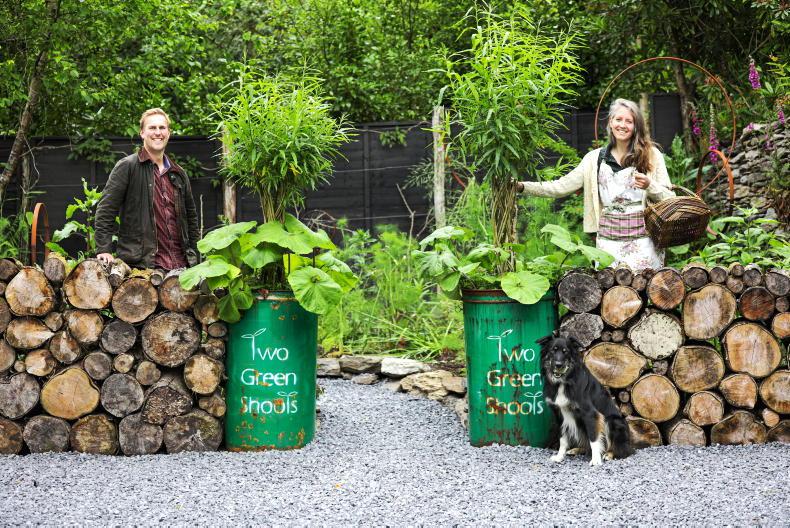
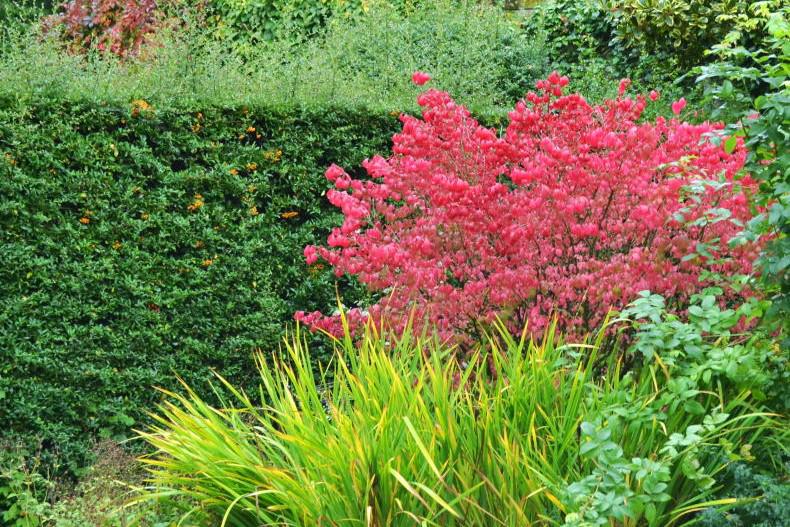
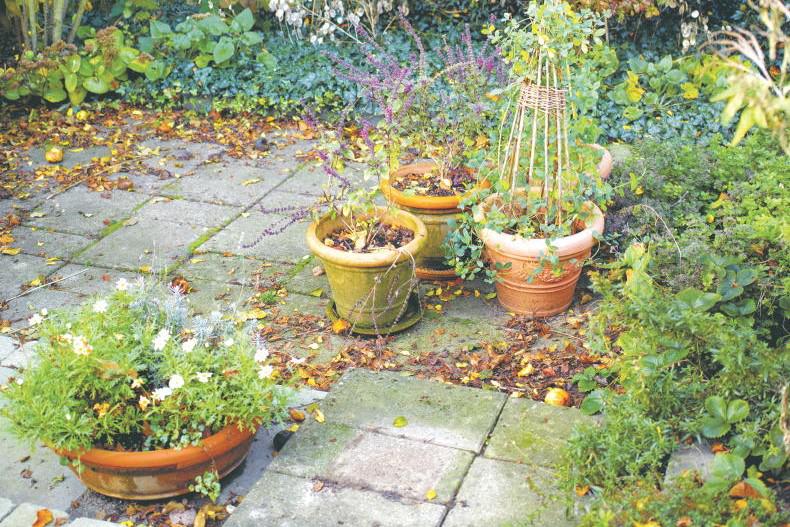
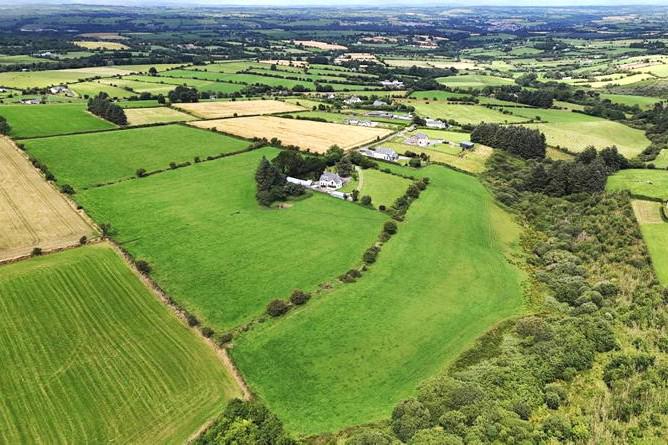

SHARING OPTIONS